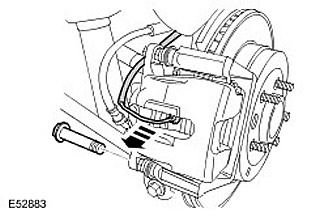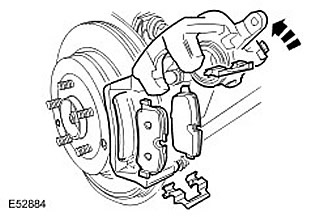Removing
CAUTION: Brake pads must be replaced as a complete axle kit, otherwise braking performance may be reduced.
CAUTION: If the brake pad wear warning light comes on, the brake pad wear sensor must be replaced.
WARNING: To prevent accidental activation of the electrically operated parking brake (EPB) and possible damage to the EPB actuator, before continuing work, remove the fuse 8 located in the fuse box in the engine compartment.
1.
WARNING: It is forbidden to carry out work on a vehicle standing on only one jack. Always support the vehicle with jack stands.
Raise and support the vehicle.
2. Remove the wheel.
3. WARNING: Always support the vehicle with jack stands. Do not use the lever to remove the sensor. The operation is performed only manually.
Right side only: Disconnect the brake pad wear indicator sensor.
4. Remove the lower brake caliper bolt.

5. Remove the brake pads.
- Turn the brake caliper up.
- Remove two clamps.

Installation
1.
CAUTION: Do not use compressed air to clean brake parts. Dust from friction materials is harmful when it enters the lungs.
Clean the brake caliper housing and base plate with special brake cleaner.
2. Inspect the O-rings on the slave cylinder piston and guide pins for damage.
3. Immerse the end of the bleed tube in a suitable container containing a small amount of the prescribed brake fluid. Place the bleed tube on the bleeder screw and loosen the screw a little.
4. Push the piston into the brake caliper housing. Tighten the bleed screw (tightening torque 14 Nm).
5. Disconnect the bleeder tube and remove the brake fluid container.
6. Install the brake pads. Install two clamps.
7. Rotate the brake caliper down. tighten bolt (tightening torque 35 Nm).
8. Connect the brake pad wear indicator sensor.
9. Repeat the above procedure on the other side.
10. Install wheels. Tighten wheel nuts (tightening torque 140 Nm).
11. Depress the brake pedal a, check the fluid level in the brake fluid reservoir and top up if necessary.
Comments on this article